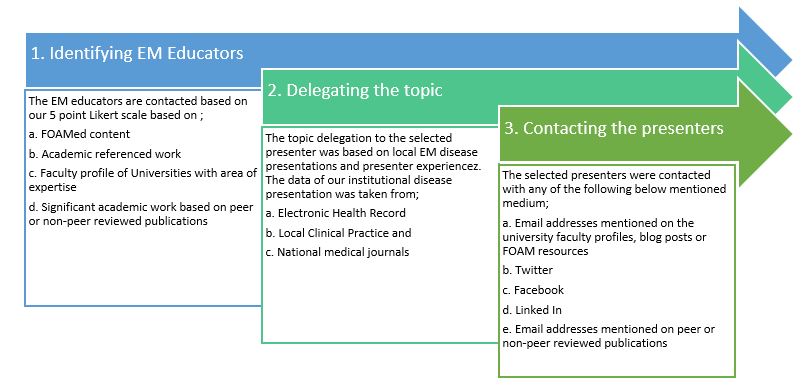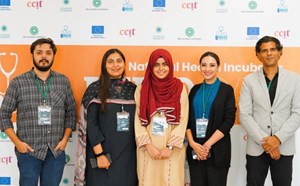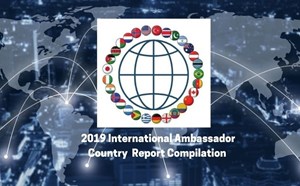
Specialized Lectures in Emergency Medicine
Shahan Waheed, MD
Emergency Medicine in Pakistan has transitioned from developing to developed stage in the last decade.1 As the specialty is progressing there was a need to improve and assimilate novel learning methods to improve education standards. Therefore, to improve the knowledge, clinical and evidence-based practice and favor collaborations with developed residency programs globally there was a need to incorporate novel learning strategies to raise the bar of learning. Specialized Lectures in Emergency Medicine (SLEM) is a virtual program for learning, collaboration and social engagement. The program invited experts from internationally acclaimed institutes with varying interests to present their experiences, observations, opinions, and protocols. It is an innovation that is based on community of practice merged with need-based assessment of a developing emergency medicine residency program of a developing country. The target learners were emergency medicine residents and physicians practicing in emergency department. The presenters are selected based on their experience, FOAM materials, research, blog posts and presentations in famous conferences. SLEM, as it is a virtual activity and can take up to 50 or more participants, but housekeeping rules need to be set and communicated to the participants. Due to the risk that uninvited participants can enter zoom virtual space and cause unanticipated disruption. We recommend enabling waiting room function of the zoom and allow only registered participant to enter the learning space.
SLEM lectures presenters were individually approached through a defined methodology shown in Figure 1. The program started in April 2021. The selection of the presenters was based on numerous free open access medical (FOAM) resources and scores of each were reviewed on an objective grading system that was adopted from Academic Life in Emergency Medicine (ALiEM).2 The presenters were selected based on their content, the referencing of their content in peer and non-peer reviewed publications, the evidence shared on their presentation, their content gradation as per the social media index and by reviewing the faculty profiles and area of expertise from the university website. The presenters also recommended their peer faculty who were similarly reviewed and assessed prior to the designation of the topic followed by the talk. The scoring tool published by ALiEM by reviewing five measurement outcomes, each using a 7-point scale, evaluated the online courses offered by the included faculty.
The identification of the presenter was followed by delegation of the topic, which was based on previous academic lectures, and area of expertise. Each topic was assigned to cater to each presenter’s profile, although there were instances in which the presenter chose to give a different topic and, based on their academic profile, the topic was approved. The identification of the topic was based on disease prevalence in Pakistani EDs, reviewed through published literature and our ED disease presentations and gaps identified during academic core meetings. The presenters were then approached through either their official email address, the email address from their FOAM website, Twitter, publications, institute website or Facebook.
The educational theory supporting our initiative was Community of Practice.3 The reason for choosing this theory was its underlying principle that states learning occurs through social engagement in authentic contexts. The SLEM presenters and audiences were individuals that share a particular interest and interact together based on this domain. The foundation of the SLEM community was based upon the interactions of the members with each other that in our case were residents and faculty of emergency medicine and their shared experiences of personal engagement within the context of a shared practice. Our SLEM conform to the three foundational elements of community of practice: a) Domain b) Community and c) Practice. Upon confirmation of the lecture an e-invitation was shared with the presenter and a zoom link prior to the talk. The session is virtual with 5 minutes introduction of the presenter, 45 minutes talk followed by 15 minutes questions and answer session. Post session evaluation form was shared with the residents and faculty to gather feedback.
The SLEM lectures’ quality was evaluated through reduced version of the Students’ Evaluation of Educational Quality (SEEQ).4 The SEEQ was originally developed by Marsh et al. is used to assess the level of student satisfaction with teacher effectiveness to improve teaching quality. The reduced SEEQ is internationally validated. It has an excellent reliability, internal consistency, validity and quality and has the flexibility to fit into individual teaching contexts. Reduced SEEQ is useful to quickly getting data and decreasing the risks of item nonresponse and has been extensively studied at the postgraduate level. The characteristics that were used per SLEM and program vision were based on characteristics of effective learning: Learning, individual rapport, enthusiasm, organization, breadth, group interaction and overall rating.

Figure 1: The SLEM method
At the end of the activity, each participant fills an online google based evaluation form to provide feedback about the activity to the activity organizers.
The program was successfully executed for 1 year, and we hold our first SLEM virtual conference on July 20, 2023 based on the above method. The program was endorsed by American College of Emergency Physicians (ACEP) and we hosted 180 plus participants virtually from all over Pakistan. This is one of the biggest virtual EM education events which has received appreciation from both the presenters and the participants. SLEM has played an important role in strengthening the academic component of our residency. Despite the sessions being held virtually and after hours, the engagement of the residents and faculty and subsequent feedback of increased knowledge and improvement in clinical practice is satisfactory. The SLEM has gained immense recognition from the junior, mid-level, senior resident trainees to junior to mid-level faculty of emergency medicine and academic sessions attendance significantly increased. SLEM focuses on the Convenience, Relevance, Individualization, Self-assessment, Independent learning and Systematic approach (CRISIS) effective for continuing medical education. Feedback was also sought from the participants for the faculty to help optimize future iterations on a pro forma that was specifically developed pertaining to the learning outcomes through a Likert scale and short-mini-interviews with group participants at completion of the activity.
References
- Waheed S, Ali N. Chief Resident Election of Emergency Department (CREED)–An innovative approach to fair and bias-free chief resident selection in a residency program. Pakistan Journal of Medical Sciences. 2022;38(6):1717.
- Brindley PG, Byker L, Carley S, Thoma B. Assessing on-line medical education resources: A primer for acute care medical professionals and others. Journal of the Intensive Care Society. 2022;23(3):340-4.
- Schwen TM, Hara N. Community of practice: A metaphor for online design? The Information Society. 2003;19(3):257-70.
- Coffey M, Gibbs G. The evaluation of the student evaluation of educational quality questionnaire (SEEQ) in UK higher education. Assessment & Evaluation in Higher Education. 2001;26(1):89-93.



